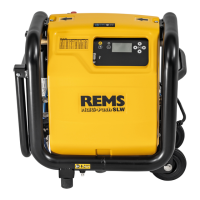Translation of the Original Instruction Manual
Fig. 1 – 9:
Fig. 1: View of inputs with operating panel and PRCD
Fig. 2: Operating panel of the input and control unit
Fig. 3: Connection to the water supply/installation
Fig. 4: View of outputs
Fig. 5: Flushing heating system/heating circuits
Fig. 6: Volume in l/m of different pipes
Fig. 7: Disinfection unit REMS V-Jet TW or cleaning and preservation
unit REMS V-Jet H
Fig. 8: Connecting hose compressor/water connections
Fig. 9: Printer
1 Fault current circuit breaker PRCD
2 RESET button
3 TEST button
4 On/Off button
5 Control lamp
6 Screen (LCD)
7 "?" button
8 Arrow buttons ↑ ↓
9 Enter button
10 Esc button
11 Arrow buttons ← →
12 Fine lter
13 Suction/pressure hose
14 Flush supply
15 Flush drain
16 Disinfection and cleaning unit supply REMS V-Jet TW or REMS V-Jet H
17 Pressure limiting valve
18 Non-return valve
19 Disinfection and cleaning unit drain REMS V-Jet TW or REMS V-Jet H
20 Flow head
21 Bottle (container) with dosing solution
22 Output pressure test with compressed air, compressed air pump
23 Compressed air hose
24 Supply pressure test with water
25 Drain pressure test with water
26 High-pressure hose
27 Water drain pressure relief
28 Compressed air tools connection
29 Emergency stop button compressor
30 Pressure gauge compressed air tank
31 Compressed air tools pressure setting
32 Compressed air tools pressure gauge
33 USB connection
34 Condensation screw plug
35 Compressed air tank
36 Operating panel
37 Protective hood
38 Connection hose compressor/water connections
39 Control lamp PRCD
40 Printer
41 LED
42 Paper tray rail
43 On/Off button, paper feed
44 Charger
45 USB lead
GeneralPowerToolSafetyWarnings
WARNING
Readallthesafetynotes,instructions,illustrationsandtechnicaldatawhich
comewiththispowertool. Failure to heed the following instructions can lead to
electric shock, re and/or severe injuries.
Keepallsafetynotesandinstructionsforthefuture.
The term "power tool" used in the safety notes refers to mains operated power tools
(with power cable).
1) Workareasafety
a) Keepworkareacleanandwelllit. Cluttered or dark areas invite accidents.
b) Donotoperatepowertoolsinexplosiveatmospheres,suchasinthepres
-
enceofammableliquids,gasesordust. Power tools create sparks which
may ignite the dust or fumes.
c) Keepchildrenandbystandersawaywhileoperatingapowertool. Distractions
can cause you to lose control.
2) Electricalsafety
a) Powertoolplugsmustmatchtheoutlet.Nevermodifythepluginanyway.
Donotuseanyadapterplugswithearthed(grounded)powertools. Unmod-
ied plugs and matching outlets will reduce risk of electric shock.
b) Avoidbodycontactwithearthedorgroundedsurfaces,suchaspipes,
radiators, ranges and refrigerators. There is an increased risk of electric shock
if your body is earthed or grounded.
c) Donotexposepowertoolstorainorwetconditions. Water entering a power
tool will increase the risk of electric shock.
d) Donotmisusetheconnectingcabletocarryorhangupthepowertoolor
topulltheplugoutofthesocket.Keeptheconnectingcableawayfrom
heat,oil,sharpedgesormovingtoolparts. Damaged or knotted cables
increase the risk of electric shock.
e) Whenoperatingapowertooloutdoors,useanextensioncordsuitablefor
outdoor use. Use of a cord suitable for outdoor use reduces the risk of electric
shock.
f) Ifoperatingapowertoolinadamplocationisunavoidable,usearesidual
currentdevice(RCD)protectedsupply. Use of an RCD reduces the risk of
electric shock.
3) Personalsafety
a) Stayalert,watchwhatyouaredoingandusecommonsensewhenoperating
apowertool.Donotuseapowertoolwhileyouaretiredorunderthe
inuenceofdrugs,alcoholormedication. A moment of inattention while
operating power tools may result in serious personal injury.
b) Usepersonalprotectiveequipment.Alwaysweareyeprotection. Protective
equipment such as dust mask, non-skid safety shoes, hard hat, or hearing
protection used for appropriate conditions will reduce personal injuries.
c) Prevent unintentional starting. Ensure the switch is in the off-position before
connectingtopowersource,pickinguporcarryingthetool. Carrying power
tools with your nger on the switch or energising power tools that have the switch
on invites accidents.
d) Removeanyadjustingkeyorwrenchbeforeturningthepowertoolon. A
wrench or a key left attached to a rotating part of the power tool may result in
personal injury.
e) Donotoverreach.Keepproperfootingandbalanceatalltimes. This enables
better control of the power tool in unexpected situations.
f) Wearsuitableclothing.Donotwearlooseclothingorjewellery.Keephair
andclothingclearofmovingparts.Loose clothing, jewellery or long hair can
get caught in moving parts.
h) Donottakeyoursafetyforgrantedandignorethesafetyrulesforpower
toolsevenifyouareveryfamiliarwiththepowertoolafterfrequentuse.
Careless handling can lead to severe injury within split seconds.
4) Power tool use and care
a) Donotforcethepowertool.Usethecorrectpowertoolforyourapplication.
The correct power tool will do the job better and safer at the rate for which it was
designed.
b) Do not use the power tool if the switch does not turn it on and off. Any power
tool that cannot be controlled with the switch is dangerous and must be repaired.
c) Disconnecttheplugfromthepowersourcebeforemakinganyadjustments,
changing accessories, or storing power tools. Such preventive safety meas
-
ures reduce the risk of starting the power tool accidentally.
d) Store idle power tools out of the reach of children and do not allow persons
unfamiliarwiththepowertoolortheseinstructionstooperatethepower
tool. Power tools are dangerous in the hands of untrained users.
e) Look after the power tools and accessoriescarefully.Checkformisalignment
orbindingofmovingparts,breakageofpartsandanyotherconditionthat
mayaffectthepowertool’soperation.Ifdamaged,havethepowertoolre-
paired before use. Many accidents are caused by poorly maintained power tools.
f) Use power tools, accessories and insert tools etc. according to these
instructions. Take the working conditions and activity being performed into
consideration. The use of power tools for purposes for which they are not intended
can lead to dangerous situations.
g) Keephandlesandgrippingsurfacesdry,cleanandfreefromoilandgrease.
Slippery handles and gripping surfaces prevent safe handling and control of the
power tool in unforeseeable situations.
5) Service
a) Haveyourpowertoolservicedbyaqualiedrepairpersonusingonly
identicalreplacementparts. This will ensure that the safety of the power tool
is maintained.
Safetynotesfortheelectronicushingand
pressuretestingunitwithcompressor
WARNING
Readallthesafetynotes,instructions,illustrationsandtechnicaldatawhich
comewiththispowertool. Failure to heed the following instructions can lead to
electric shock, re and/or severe injuries.
Keepallsafetynotesandinstructionsforthefuture.
●
Never use the power tool without the PRCD fault current circuit breaker
included. The use of a fault current circuit breaker reduces the risk of electric
shock.
●
Thepowertooldevelopsveryhighpressures,inapplicationswithcompressed
air of up to 1 MPa/10 bar/145 psi and in applications with water of up to 4
MPa/40 bar/580 psi. So be very careful. Keep third parties away from the work
area when working with the electrical device.
●
Donotusethepowertoolifitisdamaged. There is a danger of accident.
●
Examinethehigh-pressurehosesfordamageeverytimebeforeusing.
Damaged high-pressure hoses can burst and cause injury.
●
Onlyuseoriginalhigh-pressurehoses,ttingsandcouplingsforthepower
tool. This ensures that the safety of the device is maintained.
●
Applythepowertoolhorizontallyanddryforoperation. Penetration of water
into the electrical device increases the risk of electric shock.
●
Donotaimliquidjetatthepowertool,notevenforcleaning. Penetration of
water into the electrical device increases the risk of electric shock.
eng eng
16

